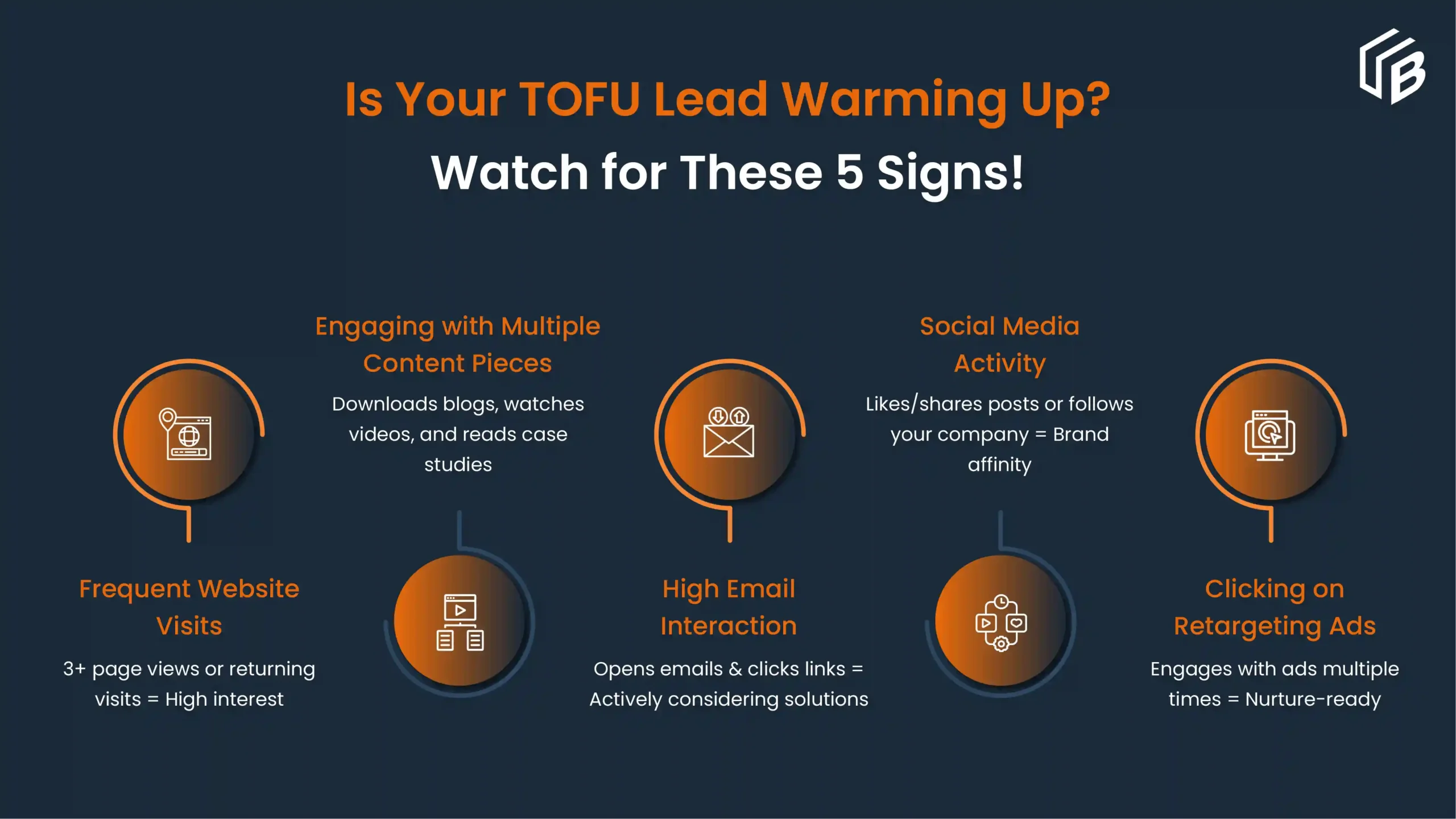
What if you could predict which top-of-the-funnel leads will convert, before they even realize it themselves? In the crowded B2B marketplace, early-stage prospects are flooded with options. But how does one identify the ones truly worth pursuing? And more importantly, how to keep them engaged before competitors swoop in?
The key lies in decoding their behavior.
Every click, download, and social interaction reveals critical insights about top-of-the-funnel leads. Are they casually browsing or actively seeking solutions? Do they prefer in-depth white papers or quick video explainers? Are they engaging with the emails or ignoring them entirely? These behavioral cues hold the answers.
But here’s the real question: Is your marketing strategy adapting fast enough? Ready to stop guessing, and start converting? Let’s dive in.
Why Analyzing TOFU Lead Behavior Matters
Not all leads in B2B marketing share similar value. Successful top-of-the-funnel lead generation demands that marketers separate business prospects who actively pursue opportunities from those who remain merely curious observers. Behavioral data analysis of content engagement patterns and website visits combined with social interaction reports helps marketers optimize their top-of-funnel marketing tactics to attract high-quality leads.
Understanding lead behavior at this early-stage is essential because:
- The ability to personalize marketing initiatives leads to higher customer engagement rates.
- The systematic approach leads companies to efficiently deploy resources toward leads showing better conversion potential.
- It improves the efficiency of top-of-funnel marketing activities by ensuring that the right messages reach the right audience at the right time.
- The process strengthens the collaborative relationship between marketing & sales teams to ensure well-qualified leads advance through the B2B sales funnel.
Key Indicators to Track TOFU Lead Behavior
To refine your top-of-funnel marketing activities, focus on these key indicators:
1. Content Engagement
One of the most significant indicators of TOFU lead behavior is content consumption. Marketers should track:
- Which blog posts, whitepapers, and case studies attract the most interest.
- The type of content formats (videos, infographics, long-form articles) that engage audiences.
- How often leads return to consume additional content, indicating returning users.
2. Website Behavior
Analyzing website interactions can provide crucial insights into a lead’s level of intent. Important metrics to track include:
- Time Spent on Pages: Longer time on key pages indicates interest.
- Bounce Rate: High bounce rates may indicate a mismatch between content and audience needs.
- Click-Through Rates (CTRs): High CTRs suggest strong engagement with calls to action.
3. Email Interactions
Email marketing remains a crucial TOFU tactic. Monitoring the following can help gauge interest levels:
- Open Rates: A high open rate suggests compelling subject lines and relevant topics.
- Click Rates: Indicates which links and CTAs are driving engagement.
- Responses and Replies: Shows deeper interest and potential for conversion.
4. Social Media Engagement
Social interactions provide valuable insights into how TOFU leads perceive a brand. Marketers should track:
- Shares and comments on posts related to industry trends or solutions.
- Follower growth and engagement over time.
- Direct interactions, such as inquiries in DMs or responses to polls.
5. Ad Performance
Paid media campaigns play a key role in top-of-the-funnel marketing strategy. Key performance indicators (KPIs) to monitor include:
- Impressions: The number of times an ad is displayed to users.
- CTR: The percentage of users who click on an ad after seeing it.
- Conversion Rates: How many leads take the next step (e.g., signing up for a webinar, downloading a report).

Top of Funnel Marketing Strategy: Turning Data into Action
It’s one thing to collect data, it’s another to truly understand your prospects. That’s where a strong customer insight strategy comes in. A successful B2B top-of-funnel marketing strategy leverages behavioral data to create customized interactions and strengthen the effectiveness of lead nurturing initiatives.
1. Segmentation & Personalization
Using behavioral data, businesses can segment their TOFU leads into categories such as:
- High-engagement leads: Those who actively consume content and respond to emails.
- Moderate-engagement leads: Those who engage occasionally but have not shown strong intent.
- Low-engagement leads: New or infrequent users who have yet to receive marketing touchpoints.
The segmentation approach enables businesses to develop personalized content and outreach strategies that generate more targeted engagement with constituents.
2. Content Strategy Alignment
Behavioral insights should shape content strategies by:
- Creating more of what resonates with TOFU leads.
- Businesses can transform their most successful content types (such as blog posts) into different media formats like videos and infographics.
- A clear mapping of content allows for smooth transitions between different content marketing funnel stages, which creates a continuous lead nurturing experience.
3. Multi-Channel Approach
An effective top-of-the-funnel marketing strategy should include:
- SEO & Organic Content: Creative blogging combined with thought leadership pieces and educational resources generates natural search traffic.
- Social Media Marketing: Utilizes platforms including LinkedIn and Twitter for B2B marketing to participate in industry forums.
- Paid Advertising: Employ display ads combined with PPC and sponsored content campaigns to elevate brand visibility.
- Email Marketing: Utilizes thoughtful newsletter design and automated sequences to sustain engagement metrics.
4. Marketing Automation
AI-driven tools help automate repetitive tasks, ensuring leads receive timely and relevant follow-ups. Key automation techniques include:
- Triggered email sequences based on lead behavior.
- Automated lead scoring to identify the most promising prospects.
- AI-powered chatbots for real-time interactions with site visitors.
5. A/B Testing for Optimization
To continuously improve top-of-the-funnel marketing tactics, businesses should run A/B tests on:
- Subject lines and email copy.
- Landing page designs and CTAs.
- Ad creatives and targeting strategies.
How Unbound’s Initiate Helps Companies Decode TOFU Lead Behavior
Unbound Initiate is a powerful solution designed to enhance TOFU lead intelligence. It helps you spot the right leads before your competitors do. It’s designed to strengthen the top of your MQL funnel by giving you deeper insight into who’s actually showing intent, long before they fill out a form. With AI-driven signals and predictive analytics, it cuts through the noise, helps your team focus on the right prospects, and turns early interest into real pipeline momentum.
Here’s how teams are using it to drive smarter outcomes:
1. Find the right-fit prospects earlier
Unbound’s extensive proprietary database and publications, marketers can connect with previously untapped audiences that closely match their Ideal Customer Profile (ICP).
2. Get clarity on what’s working
With real-time behavioral insights and lead activity tracking, you can spot which campaigns are resonating and where your best leads are coming from, so you can double down on what drives results.
3. Make lead qualification faster (and better)
The platform scores and filters leads automatically, helping your team prioritize those with the highest conversion potential, without slowing down the funnel.
4. Personalize without the guesswork
Armed with deeper audience insights, you can tailor messaging and offers that feel more relevant, boosting engagement and moving leads toward MQL status faster.
5. Strengthen the MQL pipeline
Ultimately, Unbound Initiate helps you build a healthier funnel, one where more of your TOFU leads are actually qualified, sales-ready, and primed to convert.
To sum up, businesses that integrate Unbound Initiate into their top-funnel marketing strategy benefit from data-driven decisions, which optimize ROI performance and accelerate their pipeline growth.
Conclusion
Top-of-the-funnel lead behavior decoding provides critical insights essential for improving marketing strategies focused on top-of-the-funnel action. Behavioral insights along with appropriate marketing tactics fused with advanced solutions such as Unbound Initiate enable B2B marketers to both optimize their methods and generate improved results.
Continuous tracking, together with analysis and adaptive measures, ensures TOFU leads receive the best messages when they need them. A well-structured plan enables organizations to strengthen engagement while building meaningful customer relationships, which in turn generates higher conversion rates to boost overall revenue.
Our blog
Latest blog posts
Tool and strategies modern teams need to help their companies grow.

It is for fact that today's buying environment demands more. With longer sales cycles...

To build a marketing strategy that drives real results, you need more than creative i...

The 95/5 rule in B2B marketing shows that while only 5% of buyers are ready to purcha...







